The Unauthorized History of HAARP
Nonetheless, one of the main purposes of HAARP is the generation of powerful ULF/ELF/VLF signals as stated in both the original design patent and in their list of ongoing research activities. For those researchers using sensitive ULF/ELF receivers or magnetometers for seismic correlation studies it would be useful to know when HAARP is generating ULF signals and then subtract those signals from your data set. Unfortunately, HAARP does not notify the public of the varied dates, times and frequency, or nature of modulation of its transmissions. So you would need to determine that for yourself.
1. LISTENING TO HAARP
HAARP transmits primarily on 2 frequencies: 3.39 MHZ and 6.99 MHZ. The multiple transmitters have the capability, under computer control, to quickly change to any frequency between 2.8 and 10 MHZ. Early tests have demonstrated this capacity. But the crossed array circularly-polarized dipole antennas have been “cut” for maximum Effective Radiated Power at the design frequencies.
Most radio amateurs would quickly recognize the shortwave radio propagation characteristics for the HAARP frequencies since they are adjacent to the 40 and 80 meter ham bands. This means the signals can be heard quite well at night over long distances since they reflect off the smooth F layer of the ionosphere and may bounce or skip clear around the world. During the day time the sunlight disrupts the D, E and F layers and the long distance capability of those frequencies from 1 to 10 MHZ is lost.
In March 1997 and again March 1999, HAARP performed listener reception tests, with mostly ham radio listeners, using CW morse code signals at a specified time and date on both 3.39 and 6.99 MHZ. In the March 1997 test, most listener reports show strong signals from the second F layer skip along a line from northern California to Toronto, then very little or no reception along the line from southern California to the New England states, but strong reception again along a third F layer skip line from Texas to the Carolinas.
In the March 1999 listener tests, with the then much higher power output, there was “minimal-but-readable” to “very-strong” reception in all of the US and Canada along with strong signals in Japan, Australia, United Kingdom and central Europe. Even though HAARP sends most of its 110 MW of power straight up in the air, there are still enough megawatts leaking off the side lobes and going around the world to make HAARP one of the “big boys” on 40 and 80 meters.
By June 2000 HAARP has again increased its power levels. The increased reception around the world of the 1999 test compared to the 1997 test is due not only to the increased transmitter power but also the increased plasma density of the ionospheric F layer as we approach the solar sunspot maximum in the year 2000. So world-wide reception of HAARP on short wave may drop in succeeding years.
During normal operation throughout the year, HAARP transmits on either of its frequencies with a loud 6.25 second pulse, and with either a 15 or 30 second space between pulses. When listening for the pulses they are easy to distinguish. The sound of the pulse is something like a blowtorch, modulated by the sound of a 10-ton fully loaded Mercedes lorry falling off the Chunnel train half-way to Paris. Once you have heard the HAARP pulses they are instantly recognizable.
For monitoring purposes the receiver audio can be set very low. Each of the pulses begins with two, short but very strong, sine wave multi-frequency tones which are about 20 db above the main pulse. With the receiver audio set to a minimum background hiss, the “beep-boop” sound of the pre-pulse tones can be easily heard and let you know HAARP is transmitting.
2. IONOSPHERIC HEATER RESEARCH FACILITIES
Current or Planned Research Facilities: Listed in order of final design output power (ERP)
(Transmitter power x Antenna gain = Effective Radiated Power)
3. THE EASTLUND PATENT1. HISCAT (International Radio Observatory, Sweden) (350 MW)
2. HAARP Gakona Alaska (110 MW)
3. EISCAT (Tromsö, Norway) (48 MW)
4. VOA (Voice of America – Delano, CA) (27 MW)
5. SURA (Radiophysical Research Institute, Nizhny Novgorod, Russia) (20 MW)
6. Arecibo (National Astronomy and Ionosphere Center, Puerto Rico) (20 MW)
7. HIPAS High Power Auroral Stimulation Observatory (UCLA Plasma Physics Lab – Fairbanks Alaska) (17 MW)
It would seem the primary shortwave transmitter instrument at HAARP, called the IRI (Ionospheric Research Instrument), has been built essentially according to the 1991 US Patent 5,038,664 submitted by Dr. Bernard Eastlund. The patent has the esoteric name “Method For Producing A Shell Of Relativistic Particles At An Altitude Above The Earth’s Surface.”
As with most modern patents it is long on theory and claims, but short on actual description of how the device is built. The assumption being any person knowledgeable in the field would be able to build a device to perform according to the specifications and demonstrate the claims. As such, HAARP does this quite well. The patent, originally filed in 1985, is now 15 years old so it can be assumed some improvements have been made.
Put simply, the patent describes a method using a radio beam aimed at the ionosphere where shortwave pulses from 1 to 3.6 MHZ are applied to “heat” the electrons in the ionosphere. Then the antenna is turned so as to align with the magnetic field lines in the magnetosphere, and ELF waves (in the audio range) are applied which then drive the hot electrons upward into the magnetic bottle of the magnetosphere where they remain trapped. The purpose is to enhance the number and density of hot electrons in the magnetosphere so it will become more radio reflective. Some of the beneficial reasons for making the magnetosphere into a radio reflector are listed in the patent. Of course, none of the military uses for a radio/radar mirror out at several earth diameters above the surface are listed.
The main advantage of the unique placement of HAARP in Gakona, Alaska is by placing the transmitter directly below the auroral electrojet where the magnetosphere intersects the ionosphere, the magnetic field lines there are nearly vertical. Then both operations described in the patent can be performed simultaneously and without moving the antenna. Thus the shortwave pulses heat the ionospheric electrons and the powerful ULF/ELF component of the pulses shoots the electrons up into the magnetosphere at the same time. There are several other ionospheric heaters like HAARP in operation around the world. But facilities such as Arecibo in Puerto Rico and VOA Delano in California are too far away from the auroral electrojet to accomplish both these functions.
Thus one of the primary research activities at HAARP is creating the enhanced reflectivity magnetosphere and then bouncing radio signals off the mirror to determine how well the mirror is working. This depends on how many hot electrons are injected into the magnetic bottle of the magnetosphere. To get the most electrons injected, you need to have just the right ULF/ELF signal.
When you are listening to HAARP the sound of the blowtorch is the string of pulses from two pulse generators heating the ionosphere, but slightly out of sync with each other so there is a beat frequency between them which changes numerous times and generates the ULF signals. The continuous sweeping through the ULF/ELF range is the sound of the 10-ton Mercedes lorry falling off the Chunnel train. The purpose of the research is to determine which ULF/ELF sound is most efficient.
So sometimes the researchers will fill that lorry with a flock of Welsh Sheep and other times they might try a load of Scotch Rye Whiskey. And one time it sounded like a load of Window Workers from Holland. I can tell by listening they have not yet determined which sound is most efficient at producing a shell of relativistic particles, Welsh sheep, Window Workers or Whiskey. But as do all good researchers on long term government grants they keep trying.
4. THE MYSTERIOUS 0.9 Hz ALFVEN RESONANCE
Since the early days of radio, in the age of Nikolai Tesla, it has been known the earth has a natural electromagnetic resonance. If a radio signal is sent out from point A it will then travel around to the opposite side of the planet, the antipode at point B, and then continue to travel around back to point A. If a new signal is sent at the same time the first signal arrives back, then the two will add together and seem to resonate constructively.
To calculate that resonant frequency is simple. Take the speed of the radio waves (speed of light), and divide by the distance traveled (circumference of the earth). Then 186,000 mi/s divided by 24,000 mi results in 7.75 /s or about 8 Hz. This is called the first Schumann Resonance of the earth. It is assumed radio static from large lightning discharges follow this pattern and can be heard on a ULF radio receiver as overlapping random ringing damped waves at 8 Hz.
If you take your receiver and tune below the Schumann Resonance down to about 0.9 or 1 Hz you will hear static from yet another resonant source. The cause of this Alfven Resonance is a complete mystery. It would imply there is some other path radio waves can follow which has a round trip path 8 times the size of the earth. Or it may mean there is a medium through which the radio waves travel which is 8 times slower than the speed of light. It might mean a combination of the two. It can only be a change in the speed of light or a longer distance traveled. As yet no one knows.
When radio waves or light rays travel through water or glass they are slowed down to about ¾ the speed of light. This accounts for the bending of light at air/water interfaces or by prisms. If radio waves travel through ionized gas they also are slowed down depending on the “plasma frequency” which is a function of the temperature, density and the species of ions which make up the plasma. If radio waves travel through the rocks of the earth they too are slowed down depending on the density and make-up of the rock.
As a result there are primarily three schools of thought about the source of the Alfven Resonance. These are:
Many of the members of the Elfrad group would fit into the third lithospheric group. The theory is, stresses in deep rocks in the lithoshpere created by seismic or magmatic activity can cause piezo-electric signals which radiate from the source, but due to some resonance of the rock and the distance between the crust and mantle, the signals are strongest at the resonance point which might be the Alfven Frequency. As a result the Alfven Resonance may not be due to radio waves in the air, but is actually coming from the earth due to random seismic activity around the planet. This area of study has been pursued for over 20 years, as yet, there are many indications but no clear proof has come forth.(1) magnetospheric
(2) ionospheric
(3) lithospheric interactions with radio waves
The second line of thought, ionospheric Alfven waves, has many supporters and researchers with large grants for research. Among these are teams at HAARP, along with European and Russian researchers, possibly using the EISCAT and SURA ionospheric heater facilities. The basic concept here is somehow waves travel through the thin plasma between the top of the ionosphere, the F layer, and below the magnetosphere several thousand miles above the surface, and at a speed much slower than the speed of light.
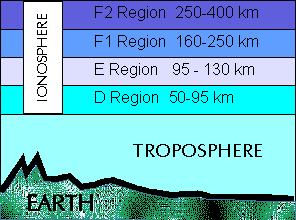
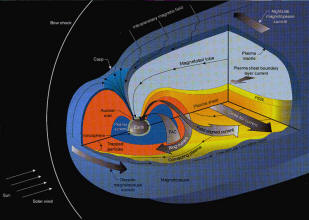
Ionosphere Magnetosphere
The third group, Magnetospheric Alfven waves, seems to have few proponents, or they have not yet published or I simply haven’t read their papers. But there is the possibility waves can travel through the plasma of the magnetosphere itself and just as the electrons are bounced back and forth from north to south magnetic pole, they may be grouped in bunches such that their density rises and falls at a 1 Hz rate. This would of course need to be along the longest path of the magnetosphere, which is along the orbit of earth. The magnetosphere in the direction of the sun is compressed by the solar wind bow shock and would be a shorter path. And the magnetosphere path away from the sun is discontinuous since it forms a long conical tail also shaped by the solar wind.
The magnetospheric tail itself, may in fact be a source of another theory for magnetospheric Alfven waves. If a thunderstorm produces those strange red and blue sprites and elves (below image), the rising plasma jets from these phenomena may radiate electromagnetic waves upward in the direction of the magnetic tail.
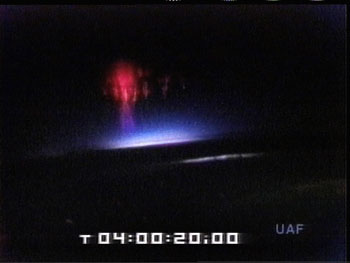
What this shows is, there is a tight horse race among many researchers all looking in different places for the source of the mysterious Alfven Resonance at 0.9 Hz. It would seem the lithospheric group is being left out in the cold, while most of the grant money is going to the ionospheric group. Among the grantors of science funding, those people who build radios and then strangely bury their antennas in the ground are often viewed as being like those hardy folk who eat dirt and drink motor oil for breakfast. Thus most of the grant money goes to places like HAARP.
This also points out the reason for the extreme mystery and secrecy surrounding the projects at HAARP. If you want to find out what is happening at HAARP the only place you might find out is during a cocktail party after an international geophysical conference. Even then if you are lucky enough to collar a researcher, he will only give you a wink and a nod, and that’s about it. Why? Well, he doesn’t want his competitors and fellow researchers to know what he’s doing. He wants to collect his data, write his paper, be first to get into the Journal of Geophysical Research, and then proudly stake his claim as the discoverer of the source of the Alfven Resonance. All that creates an aura of academic secrecy around the HAARP activities which is even tighter than a place like, say, Los Alamos Labs.
With an environment of such high secrecy, the public is inclined to believe all manner of secret military activities such as, futuristic weapons, weather and mind control projects along with possibly communication with ETs, are all occurring at HAARP. When in fact, most of the secrecy is due to normal academic behavior when a scientific breakthrough is about to occur. But then again, a prime reason for all the secrecy at HAARP is… the US Navy.
5. THE SUBMARINE COMMUNICATION CODES
In the 1960’s the US Navy began experiments using ELF transmissions to talk to submarines deep in the ocean. First experiments in 1969 from a 14 mile antenna at Clam Lake, Wisconsin proved the concept would work. They later built a 28 mile antenna and then in 1987 a 56 mile antenna in Upper Michigan. But the US Navy was not alone. The British built a large ELF antenna in Glen Cally Forest, Scotland, the French built one at Roshay, and the Soviets built two very large antennas at Riga and Gomel. The US Navy systems broadcast in the ELF range from 40 to 50 Hz and 70 to 80 Hz, but mostly around 76 Hz. The Soviet system actually operated down in the ULF range at the first Schumann Resonance of 8 Hz. It turns out, the lower in frequency the transmission, the deeper in the ocean the signals can be received.
Early on the Navy started having problems with the neighbors. Many taxpaying citizens complained about having those big wires putting out some kind of radiation in their backyards. Some people complained about hearing strange noises, ringing and humming in their ears. The cheeseheads in Wisconsin complained the Navy might be drying up their dairy cows. Angus MacDonough in Michigan was sure it was the Navy who was scaring his sheep. And the last thing a Scotsman wants is scared sheep. The Navy needed to find another way to talk to its submarines.
In 1985 along comes the Eastlund Patent. If you look at the patent another way, it could be, by using shortwave signals to reach up and jiggle the auroral electrojet at a ULF/ELF frequency, then the whole electrojet becomes a 10,000 mile ULF antenna—and its not in anybody’s backyard. With such a large antenna the frequency could go all the way down to the Alfven Frequency of 0.9 Hz and the Navy could talk to even deeper boats. By hiding its submarine antenna up in the ionosphere, the Navy wouldn’t need to worry about the neighbors over the back fence complaining, nor worry about Angus MacDonough being scared sheepless.
The Navy called in a bunch of ULF/ELF researchers and made them an offer. The Navy would supply them a fabulous research facility with state-of-the-art equipment, computer-controlled everything, the best instrumentation available, wonderful living quarters, and a nearby Domino’s and Burger King only 2 hours away by overland dogsled. The researchers were ecstatic. But what did the Navy want in return? Nothing. What? Nothing.
While the magnetic bottle stuffers would be shooting hot electrons into the magnetosphere then turning off the pulse and checking to see how well the mirror was working, all the Navy wanted was that 30 seconds of nothing in between the pulses. And while the 0.9 Hz Alfven wave hunters would be using a ULF pulse to ring the magnetospheric bell and then turn off the pulse so they could take a look around and see what’s shakin’ up there and maybe discover the Alfven Resonator, all the Navy wants is maybe 15 seconds of that nothing between pulses. To the researchers that was no problem. With mega-dollars in research facilities, grants and possibly Nobel Prizes laying on the bargaining table, and all the Navy wants in return is Nothing? Such a deal. Everybody smiled, shook hands and soon after HAARP construction began.
If you go to the HAARP Internet web site and look at the nearly-live Induction Magnetometer data you would sometimes see at the bottom of the chart some bright orange lines which seem to be the ULF output of HAARP impressed upon the earth’s magnetic field. If you could expand the scale you could actually see the pattern of pulses and spaces of the code. But the output of the magnetometer is averaged over a period of 102.4 seconds. A rather odd number but guaranteed to average out any indication of 15 or 30 second pulses and spaces.
This would imply the Navy is rather shy about publishing the pattern of nothing on the Internet. So I will assist the Navy in getting over its shyness by publishing it for them. Below are three hour samples of the spaces in between the HAARP pulses. I have indicated a 30 second space with a “1” and a 15 second space with a “0.” I have arbitrarily broken the pattern into blocks of 4 to make it easy to read, but in fact the pattern is continuous. These presumably could be called “sweet nothings” from the Navy to their boys in the boats:
I have made an attempt to decode the second sample. It goes something like, “… SUBCOMNAV to R73 proceed 7E5H the smoking lamp is li…” and then the message breaks off. I may have missed a few of the characters but Mr. Merkley’s cryptography course was not my favorite high school elective. For some reason there weren’t any girls in the class. If anybody has a better way to decrypt the code, let me know.0735-0800 UT June 20 2000 3.39 MHZ
1110 0011 0001 0000 0100 0100 0000 0010 1111 1011 0101 0101 0110 1010 1…
0805-0830 UT June 20 2000 3.39 MHz
1010 1101 0110 1010 1010 0010 0010 0010 0000 0101 0110 1010 1011 0…
1400-1425 UT May 4 2000 3.39 MHZ
1001 0001 0001 0001 0010 1010 1010 0101 0101 0101 0101 0100 1000 10…
6. THE HAARP OBSERVATIONS
In general during the year 2000 spring months HAARP was transmitting on a weekday schedule with almost no broadcasts on weekends. The spring transmissions seemed to stop on May 27, 2000 with only one single very strong pulse on 3.39 MHZ at 0930 UT, then no more transmissions until the summer program began on June 6, 2000. The summer program includes both weekday and weekend transmission. In some cases the times listed here are approximate since the signal may have faded in and then faded out so I could not determine the exact time.
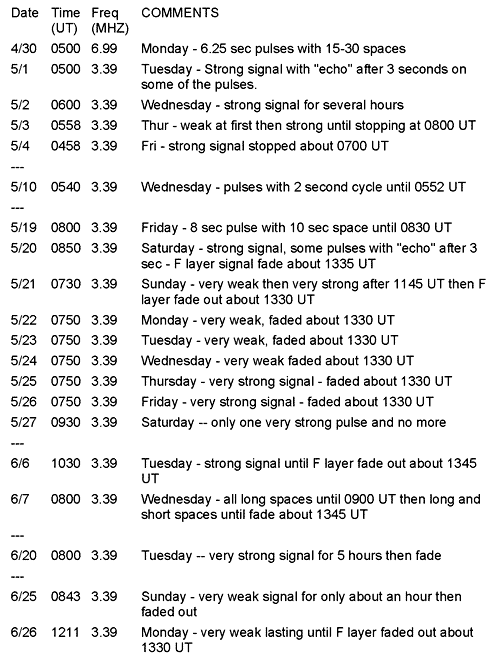
7. CONCLUSION
Have I proven HAARP to be the source of the mystery 0.9 Hz ULF signal? I would have to conclude, No. But it would certainly be the most likely. I have tried to show all the possible sources for man-made signals at the pc1, first Alfven frequency. There are generally two types of possible sources. The first is the ULF/ELF transmitters of which there are only 6, two in Russia, two in the United States, and one each in Britain and France. And a new class of possible sources which are the Ionospheric Heaters with access to the Northern Polar Auroral Electrojet which could modulate the electrojet at the pc1 frequency. In this group there are only 4 possible devices, HISCAT in Sweden, HAARP in Alaska, EISCAT in Norway, and the “little peanut whistle” 17 MW HIPAS operated by UCLA in Fairbanks, Alaska.
I would suggest all of the ground based ULF/ELF transmitters can be eliminated. To use a loop transmitting antenna at 1 Hz would require a loop with a diameter of about 1000 miles. There is no indication anybody has built one of these. The existing transmitters might be used with the smaller existing antennas but series coils with a length of about 900 miles would need to be wound and inserted in the loop. That would not be very efficient since about 98% of the transmitter power would go into heating the coils and not being transmitted. People have done some silly things before but that is definitely a dumb idea. So we can toss out all the existing ULF/ELF transmitters as not very likely to be the source of the mystery 0.9 Hz signal.
Among the Ionospheric Heater devices, if we skip the UCLA device, HIPAS, as being too small and not really in the business of modulating the Auroral Jet, then that leaves 3 possible sources.
The HISCAT facility in Sweden looks like a good candidate except for one problem, its still in the conceptual stage and hasn’t been built yet. And a lot of the parts for HISCAT will be made out of refurbished parts from EISCAT. So we can exclude HISCAT, and that leaves us with two possible sources for the mysterious 0.9 Hz ULF wave, HAARP and EISCAT. Are we ready to flip a coin and guess which one? Not yet.
- HISCAT, with 350 MW is the largest
- then comes HAARP at 110 MW
- then there is EISCAT with 48 MW
EISCAT (European Incoherent SCATter) facility is co-jointly operated by geophysical research councils in Norway, Sweden, Finland, Japan, France, the United Kingdom and Germany. Their primary focus is using a radar scatter device to map the auroral region, but they do have an ionospheric heater to assist the radar. Their ionospheric heater device is very similar to HAARP’s. It has multiple transmitters, uses multiple crossed dipole antennas, but it does have far fewer transmitters and dipoles than HAARP.
Like HAARP the EISCAT transmitters can work over a large range from 3.85 to 8 MHz. But EISCAT only uses the assigned frequencies of 4.04, 4.544, 4.9128, 5.423, 6.77, 6.96, 7.1, 7.953 MHz. But before you rush over to your receiver and try to tune them in, you need to remember, if you are in the US, and since Norway is around the other side of the planet, and the only possible short wave radio path is over the pole. And during the summer the north pole its always sunny, especially this time of year when we have the midnight sun. That means there is no way to use F layer shortwave skip to receive the EISCAT signals.
If you want to tune them in to find out if they are modulating their transmitters with ULF waves you need to wait until it is dark both in the US and Norway and that only occurs during November, December and January. But, not to worry. Unlike HAARP which is very secretive, the EISCAT group is very academic, open and cooperative. You can actually write to them, maybe even e-mail them and ask, “Hey, you guys sending out 0.9 Hz pc1 Alfven frequencies on your transmissions?” And they would probably write back, “Nope, not us.”
Well, without any further evidence, its time to flip the coin. Is it HAARP or EISCAT? And every time I flip the coin it keeps coming up HAARPS.
Its my wish that this information has been useful to you. I have not proven what is the source of the mysterious 0.9 Hz signal, but I have looked at all the possible contenders and tried to eliminate all but the most likely. Its now up to you to do a little digging, a little researching, and maybe some listening to determine from where did the signal come.



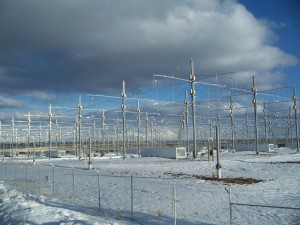
No comments:
Post a Comment